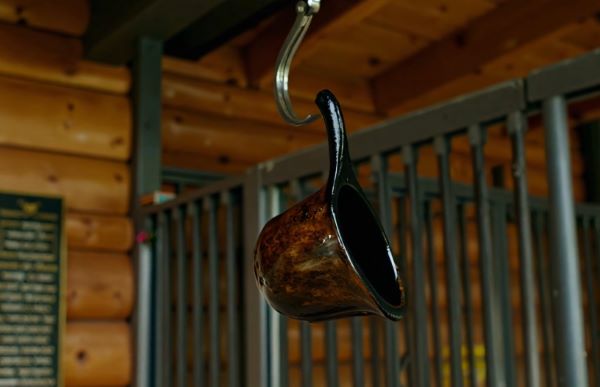The frog allows the hoof to expand upon landing. It also plays a major role in the hoof’s ability to absorb shock.
A healthy frog is smooth and wide. It’s even on both sides. It makes some ground contact at the heels, sloping downwards towards its tip. The ridge running through the middle (the central sulcus) is shallow and clear. This helps the heels expand.
You can assess the health of a hoof’s frog after trimming the walls, heels and dead sole within the collateral grooves. Lay your rasp across the heel-landing platform. Check that the frog is level 1/3 of the way down, making contact. Then lay your rasp across the hoof walls at the tip of the frog. This area should not be weight bearing.
If necessary, trim the frog level with the heels, using your farrier knife. Next, make sure it follows a slope downwards towards its tip. Clear the central sulcus of dirt and debris.
If you’ve cleared the collateral grooves the frog should be able to expand properly. If it bulges over these, trim the sides carefully to bring it back into place.
A horse that’s just come out of shoes may have a shrivelled frog. Confined to the shoe, it hasn’t been able to expand naturally. The result is contracted heels, poor shock absorbance and a deep central sulcus. This can be a breeding ground for thrush.
But the frog is a softer tissue, and will grow relatively fast. Keep it clean, in the correct position, and give your horse regular exercise. In time it will expand.
And now onto Andrew.

Hoof Frogs: The Unsung Heroes of Your Horse’s Feet
“Let’s give a little love to hoof frogs, shall we? These rubbery, V-shaped structures on the bottom of your horse’s hooves don’t get nearly enough credit for all the hard work they do. Sure, they’re not as flashy as a shiny coat or perfectly trimmed ears, but hoof frogs are essential for keeping your horse comfortable and sound.”
“First off, what exactly are hoof frogs? Think of them as your horse’s shock absorbers. They cushion each step, absorb impact, and help distribute weight evenly across the hoof. Plus, they’re a key player in hoof health, promoting circulation and keeping everything down there functioning like a well-oiled machine.”
“But here’s the thing—hoof frogs need TLC, too! If your horse spends a lot of time in muddy paddocks or wet conditions, their frogs can become soft and prone to infections like thrush. (And let’s face it—nobody wants to deal with the smell of thrush.) Keep those hooves clean by picking them out daily and paying extra attention to the frog area. A clean frog is a happy frog!”
“Another tip? Regular trims by your farrier are a must. If the hoof frogs get overgrown or ragged, they can’t do their job properly. And don’t forget the importance of a balanced diet—strong frogs thrive on good nutrition, just like the rest of the hoof.”
“If you notice any funky smells, tenderness, or cracking in the hoof frogs, don’t ignore it! A quick call to your farrier or vet can help nip any issues in the bud.”
“So, the next time you’re picking out hooves, take a moment to appreciate those hardworking hoof frogs. They might not be glamorous, but they’re definitely hoof MVPs! Andrew”
Next up
How can I tell if my horse’s hoof frog is healthy, and what can I do to prevent issues like thrush or infections?
The hoof frog is a crucial part of your horse’s hoof, acting as a shock absorber and helping with circulation. To keep it healthy, regularly clean the hooves, watch for signs of infection like thrush, and ensure your horse’s hooves are properly trimmed and balanced.